March 6, 2015 at 4:02 pm
When the National Weather Service in Maine announced that this was the coldest February on record, they simply affirmed what we already knew…February was freezing.
[caption id="attachment_530" align="alignright" width="300"]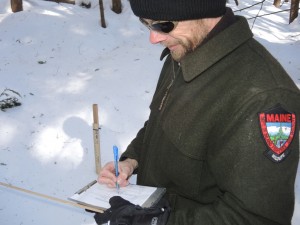 IFW Wildlife Biologist John Pratte records snow depth at a winter weather station in the Jamies Pond Wildlife Managment Area[/caption]
While we know what effect this winter has had on us (raise your hand if you are sore from repeatedly shoveling your walkway/roof/driveway/etc.), it takes more information than just a temperature reading to gauge how this winter affects deer.
That’s why IFW wildlife biologists set up weather recording stations throughout the state, and visit them weekly from the end of November into April. They record data that helps us better manage the deer population.
White-tailed deer are at the northern edge of their range here in Maine, and as you know, the severity of a Maine winter can severely impact deer survival.
Deer have a better chance of surviving Maine’s winters if they can overwinter in a mature softwood forest, an older forest comprised of hemlock, fir, spruce and cedar; which is better known as a deer yard. The thick forest canopy actually lessens the impact of winter, decreasing snow depths, moderating temperatures, and providing food in the form of litterfall and browse.
[caption id="attachment_536" align="alignright" width="225"]
IFW Wildlife Biologist John Pratte records snow depth at a winter weather station in the Jamies Pond Wildlife Managment Area[/caption]
While we know what effect this winter has had on us (raise your hand if you are sore from repeatedly shoveling your walkway/roof/driveway/etc.), it takes more information than just a temperature reading to gauge how this winter affects deer.
That’s why IFW wildlife biologists set up weather recording stations throughout the state, and visit them weekly from the end of November into April. They record data that helps us better manage the deer population.
White-tailed deer are at the northern edge of their range here in Maine, and as you know, the severity of a Maine winter can severely impact deer survival.
Deer have a better chance of surviving Maine’s winters if they can overwinter in a mature softwood forest, an older forest comprised of hemlock, fir, spruce and cedar; which is better known as a deer yard. The thick forest canopy actually lessens the impact of winter, decreasing snow depths, moderating temperatures, and providing food in the form of litterfall and browse.
[caption id="attachment_536" align="alignright" width="225"]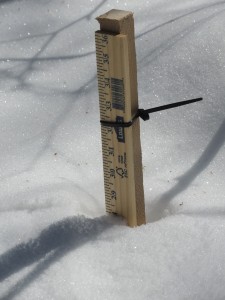 Snow depths are monitoried at several locations in a variety of forest habitats.[/caption]
[caption id="attachment_535" align="alignleft" width="225"]
Snow depths are monitoried at several locations in a variety of forest habitats.[/caption]
[caption id="attachment_535" align="alignleft" width="225"]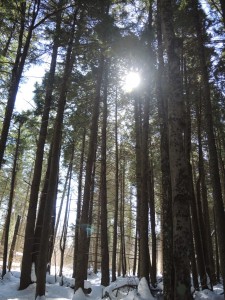 Older, mature softwood trees such as these hemlocks provide both cover and food.[/caption]
In order to track the effects of winter on Maine’s deer, IFW biologists monitor winter weather statewide, recording such things as temperature, humidity, snow depths, and snow characteristics throughout Maine.
Biologists install winter severity stations that record temperature and humidity at nearly 30 locations statewide. IFW biologists also visit these stations weekly to measure snow depths at multiple locations in a variety of habitats including mature softwood canopies, open hardwood stands, and others.
Along with measuring the depth of the snow, biologists check the physical characteristics and sinking depths of the snow. As snow gets deeper, deer will sink when they step in the snow, and they expend more energy moving through the snow. Expending energy can be problematic for deer in winter since there is little high-quality food available during the winter, and they rely on stored fat reserves. However, if snow is compact or has a thick crust due to rain or warm weather, deer can walk on top of the snow and not expend as much energy as when they are sinking in softer snow.
[caption id="attachment_534" align="alignright" width="300"]
Older, mature softwood trees such as these hemlocks provide both cover and food.[/caption]
In order to track the effects of winter on Maine’s deer, IFW biologists monitor winter weather statewide, recording such things as temperature, humidity, snow depths, and snow characteristics throughout Maine.
Biologists install winter severity stations that record temperature and humidity at nearly 30 locations statewide. IFW biologists also visit these stations weekly to measure snow depths at multiple locations in a variety of habitats including mature softwood canopies, open hardwood stands, and others.
Along with measuring the depth of the snow, biologists check the physical characteristics and sinking depths of the snow. As snow gets deeper, deer will sink when they step in the snow, and they expend more energy moving through the snow. Expending energy can be problematic for deer in winter since there is little high-quality food available during the winter, and they rely on stored fat reserves. However, if snow is compact or has a thick crust due to rain or warm weather, deer can walk on top of the snow and not expend as much energy as when they are sinking in softer snow.
[caption id="attachment_534" align="alignright" width="300"]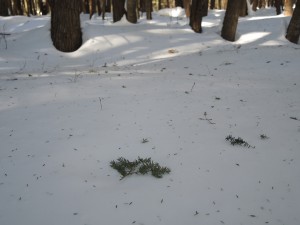 Litterfall, such as this hemlock bough, provides some nutritional value to foraging deer.[/caption]
This weather data is recorded from November into April, summarized, and is one of the important factors in deciding how many Any Deer permits should be issued. Generally, the more severe the winter, fewer permits are issued.
So while winter weather can severely impact Maine’s deer herd, by accurately monitoring the severity of Maine’s winters, biologists can work to offset the influence of winter in order to ensure that Maine continues to have a healthy deer population.
[caption id="attachment_533" align="alignleft" width="300"]
Litterfall, such as this hemlock bough, provides some nutritional value to foraging deer.[/caption]
This weather data is recorded from November into April, summarized, and is one of the important factors in deciding how many Any Deer permits should be issued. Generally, the more severe the winter, fewer permits are issued.
So while winter weather can severely impact Maine’s deer herd, by accurately monitoring the severity of Maine’s winters, biologists can work to offset the influence of winter in order to ensure that Maine continues to have a healthy deer population.
[caption id="attachment_533" align="alignleft" width="300"]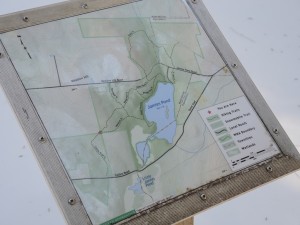 The Jamies Pond Wildlife Managment Area is just one of nearly 30 locations where IFW wildlife biologists monitor weather.[/caption]
The Jamies Pond Wildlife Managment Area is just one of nearly 30 locations where IFW wildlife biologists monitor weather.[/caption]
 IFW Wildlife Biologist John Pratte records snow depth at a winter weather station in the Jamies Pond Wildlife Managment Area[/caption]
While we know what effect this winter has had on us (raise your hand if you are sore from repeatedly shoveling your walkway/roof/driveway/etc.), it takes more information than just a temperature reading to gauge how this winter affects deer.
That’s why IFW wildlife biologists set up weather recording stations throughout the state, and visit them weekly from the end of November into April. They record data that helps us better manage the deer population.
White-tailed deer are at the northern edge of their range here in Maine, and as you know, the severity of a Maine winter can severely impact deer survival.
Deer have a better chance of surviving Maine’s winters if they can overwinter in a mature softwood forest, an older forest comprised of hemlock, fir, spruce and cedar; which is better known as a deer yard. The thick forest canopy actually lessens the impact of winter, decreasing snow depths, moderating temperatures, and providing food in the form of litterfall and browse.
[caption id="attachment_536" align="alignright" width="225"]
IFW Wildlife Biologist John Pratte records snow depth at a winter weather station in the Jamies Pond Wildlife Managment Area[/caption]
While we know what effect this winter has had on us (raise your hand if you are sore from repeatedly shoveling your walkway/roof/driveway/etc.), it takes more information than just a temperature reading to gauge how this winter affects deer.
That’s why IFW wildlife biologists set up weather recording stations throughout the state, and visit them weekly from the end of November into April. They record data that helps us better manage the deer population.
White-tailed deer are at the northern edge of their range here in Maine, and as you know, the severity of a Maine winter can severely impact deer survival.
Deer have a better chance of surviving Maine’s winters if they can overwinter in a mature softwood forest, an older forest comprised of hemlock, fir, spruce and cedar; which is better known as a deer yard. The thick forest canopy actually lessens the impact of winter, decreasing snow depths, moderating temperatures, and providing food in the form of litterfall and browse.
[caption id="attachment_536" align="alignright" width="225"] Snow depths are monitoried at several locations in a variety of forest habitats.[/caption]
[caption id="attachment_535" align="alignleft" width="225"]
Snow depths are monitoried at several locations in a variety of forest habitats.[/caption]
[caption id="attachment_535" align="alignleft" width="225"] Older, mature softwood trees such as these hemlocks provide both cover and food.[/caption]
In order to track the effects of winter on Maine’s deer, IFW biologists monitor winter weather statewide, recording such things as temperature, humidity, snow depths, and snow characteristics throughout Maine.
Biologists install winter severity stations that record temperature and humidity at nearly 30 locations statewide. IFW biologists also visit these stations weekly to measure snow depths at multiple locations in a variety of habitats including mature softwood canopies, open hardwood stands, and others.
Along with measuring the depth of the snow, biologists check the physical characteristics and sinking depths of the snow. As snow gets deeper, deer will sink when they step in the snow, and they expend more energy moving through the snow. Expending energy can be problematic for deer in winter since there is little high-quality food available during the winter, and they rely on stored fat reserves. However, if snow is compact or has a thick crust due to rain or warm weather, deer can walk on top of the snow and not expend as much energy as when they are sinking in softer snow.
[caption id="attachment_534" align="alignright" width="300"]
Older, mature softwood trees such as these hemlocks provide both cover and food.[/caption]
In order to track the effects of winter on Maine’s deer, IFW biologists monitor winter weather statewide, recording such things as temperature, humidity, snow depths, and snow characteristics throughout Maine.
Biologists install winter severity stations that record temperature and humidity at nearly 30 locations statewide. IFW biologists also visit these stations weekly to measure snow depths at multiple locations in a variety of habitats including mature softwood canopies, open hardwood stands, and others.
Along with measuring the depth of the snow, biologists check the physical characteristics and sinking depths of the snow. As snow gets deeper, deer will sink when they step in the snow, and they expend more energy moving through the snow. Expending energy can be problematic for deer in winter since there is little high-quality food available during the winter, and they rely on stored fat reserves. However, if snow is compact or has a thick crust due to rain or warm weather, deer can walk on top of the snow and not expend as much energy as when they are sinking in softer snow.
[caption id="attachment_534" align="alignright" width="300"] Litterfall, such as this hemlock bough, provides some nutritional value to foraging deer.[/caption]
This weather data is recorded from November into April, summarized, and is one of the important factors in deciding how many Any Deer permits should be issued. Generally, the more severe the winter, fewer permits are issued.
So while winter weather can severely impact Maine’s deer herd, by accurately monitoring the severity of Maine’s winters, biologists can work to offset the influence of winter in order to ensure that Maine continues to have a healthy deer population.
[caption id="attachment_533" align="alignleft" width="300"]
Litterfall, such as this hemlock bough, provides some nutritional value to foraging deer.[/caption]
This weather data is recorded from November into April, summarized, and is one of the important factors in deciding how many Any Deer permits should be issued. Generally, the more severe the winter, fewer permits are issued.
So while winter weather can severely impact Maine’s deer herd, by accurately monitoring the severity of Maine’s winters, biologists can work to offset the influence of winter in order to ensure that Maine continues to have a healthy deer population.
[caption id="attachment_533" align="alignleft" width="300"] The Jamies Pond Wildlife Managment Area is just one of nearly 30 locations where IFW wildlife biologists monitor weather.[/caption]
The Jamies Pond Wildlife Managment Area is just one of nearly 30 locations where IFW wildlife biologists monitor weather.[/caption]Categories